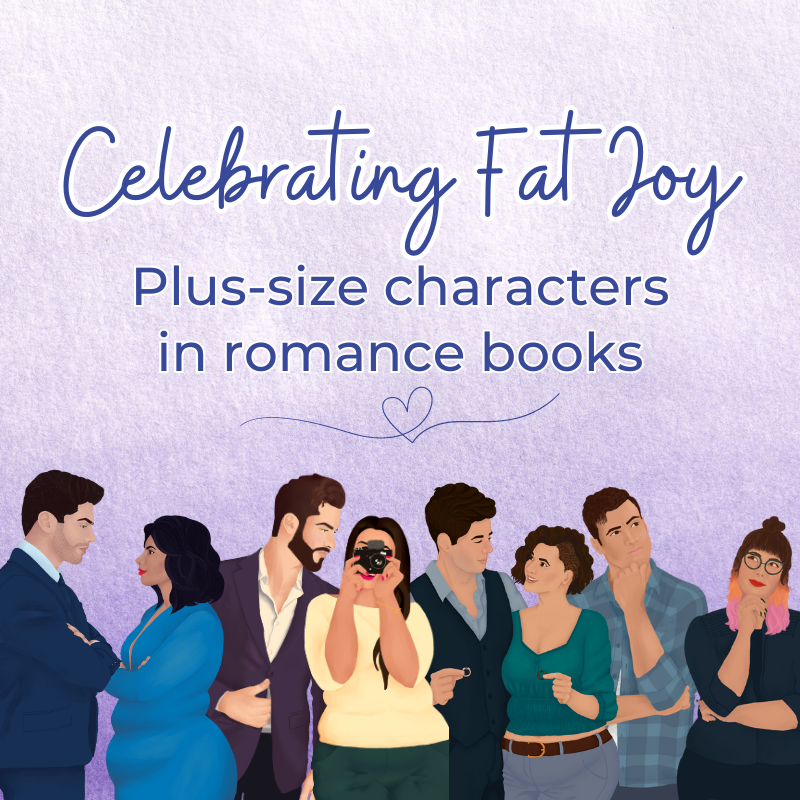Celebrating Fat Joy: Plus-size characters in romance books
April 29, 2024 | General

Seeing plus-size characters in romance books is a matter close to my heart. Every book I’ve written has a curvy FMC! Admittedly, I can’t say that of my MMCs — they exist in different parts of the spectrum, from sculpted, muscular Liam in Seeking Stars, to Gabe, a man with “love handles”, in Yours, For Now.
As I wrote Jake in Yours, Finally, my first proper plus-size MMC, I revisited the purposefulness with which I include fat bodies in my romance books. If art, writing, and reading are political, how are curvy characters part of that?
First, we need to talk about fat-phobia. Even as a thin child, I was put on diets (as young as 10 years old!). By the time I was 16, my environment made sure I knew I was fat. I learned that I should feel shame about it, and work hard to not be my size anymore. I constantly hear that my body is wrong, whether from people in my every day life, the media, or the medical system.
This isn’t a unique experience. Regardless of the size of your body, chances are that you’re aware of many of the beliefs pushed onto us about fat people. Even if you are in a smaller body, it’s possible you don’t feel like it. That’s the extent to which anti-fat bias exists in the world; it’s pervasive, oppressive, and difficult to eradicate. As Sabrina Strings explains in her book Fearing The Black Body, racism, anti-fat oppression, and other forms of discrimination intertwine in culture.
Fortunately, I’ve been in the fat-liberationist space for many years, and have been able to deconstruct many of these beliefs. This is why I look at my role as an author, as a person in this space, and as a reader through this lens.
The body in the romance genre
Every time I read or write a book, I pay attention to body descriptions. Does the text tell us the characters’ skin color, or are we to assume that they’re white unless otherwise stated? Do we get descriptors to indicate whether we have thin or fat main characters? When a writer describes bodies, how do they do so? Are bodies’ characteristics gendered? What kind of characters carry fat? (Hopefully not only the villains and those used for comic relief!)
I know most people don’t move through the world using this filter. Within the romance genre, we often hear that readers just want to escape reality. In my opinion, the assumption that entertainment and rest exist only if we shut down our social awareness comes from privilege and a lack of nuanced understanding. Even more so, I think active engagement with the media we consume is one of our responsibilities as world citizens. Inspecting the way we address issues in books helps us take a step forward to making the world a better place.
This means paying attention to the stories we craft and read. Recognizing fat-phobic or other discriminatory themes in books requires awareness, and learning to recognize violent language. If we don’t, we internalize it. Books and other media help shape our reality, and so the bodies we describe and celebrate matter.
In the romance genre, we’re actively determining who gets a Happily Ever After — I believe everyone should get theirs. To make that happen, we need stories with diverse characters. But we will only have more of those if we actively seek them.
Writing plus-size characters in romance
When we make fat characters the main focus of romance books, we’re doing something revolutionary. Diet culture and fat-phobia dictate that large bodies should be hidden and shamed. If we want to flip that script in stories with a Happily Ever After, we have to do it purposefully.
One way to highlight plus-size bodies in books is by including them in covers. Often, stock photography is sorely lacking in curvy bodies. This is even worse if we’re looking for large bodies with intersecting identities, like racialized fat bodies, or large bodies using mobility aids. Illustrated covers are often not much better. It’s rare to see book covers that clearly show the curves and shadows of a soft body. Because of this, making a point of seeking visual representations of plus-size characters for book covers is a good place to start.
Another way to show larger bodies on page is by using the right descriptors: words like round, soft, plush, ample, and so many others. Not only that, but we can recount how a fat body moves in the world. From the difficulty of finding nice clothes to chairs with armrests that dig into your hips, existing in a larger body means particular experiences in life.
Celebrating Fat Joy
People in larger bodies have complex lives, like everybody else. In this sense, stories that include plus size characters can take any tone. They can be happy or sad, be contemporary or belong in fantasy, and feature characters with multiple intersections.
As a romance author, I write stories that help me visualize the world I want. With that intention in mind, my books include fat neutrality and fat joy. I write heroes who enjoy seeing the way their heroine’s bodies jiggle, heroines that have no self-criticism, and I use unbiased terms to describe bodies.
In Yours, Finally (Book 3 of my Cozy Latine Billionaires series), Jake and Vi fall in love because of who they are as a whole, not because or despite the bodies they have. There’s comfort and pleasure in who they are with each other.
As a writer, writing fat bodies this way warms my heart. My goal is that people reading my stories will see what it’s like to live our best life as larger people, and getting our own Happily Ever After. Just like my characters, I feel the joy, too.